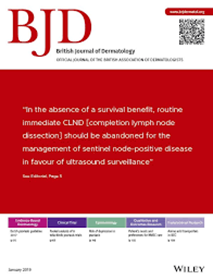在英国使用反射共聚焦显微镜诊断恶性黑色素瘤和白斑病:单个中心的前瞻性观察试验。
IF 11
1区 医学
Q1 DERMATOLOGY
引用次数: 0
摘要
背景以前使用反射共聚焦显微镜 (RCM) 成像的研究显示,RCM 对恶性黑色素瘤 (MM) 具有很高的灵敏度和特异性,但迄今为止还没有针对英国人群的研究。目标研究假设,在英国私立二级医疗机构中,RCM 可用于前瞻性地准确诊断 MM 和恶性白斑 (LM),并由一名临床医生进行诊断。该研究评估了将 RCM 用作常规筛查程序的可能性。方法 连续招募了 597 名患者,这些患者在临床检查后被列为 MM 或 LM 的鉴别诊断对象。活检前,由一名皮肤科医生 [HS] 对临床、皮肤镜检查和 RCM 结果进行连续记录。成像使用的是臂装共聚焦显微镜,除非接触受限,需要使用手持探针。每种方式都会对 MM 的可能性进行评分,每次诊断都是在上次诊断的基础上进行的。结果 734 个病灶被纳入分析,其中包括 86 个 MM 和 LM,中位直径为 7.0 毫米。良恶性比例为 3:1(包括非黑素细胞恶性肿瘤),仅 MM 和 LM 的良恶性比例为 8.3:1。临床检查对 MM 和 LM 的敏感性和特异性分别为 62.8%(95% CI 51.70% 至 72.98%)和 63.2%(59.27% 至 66.84%);皮肤镜检查的敏感性和特异性分别为 91.9%(83.95% 至 96.66%)和 42.1%(38.14% 至 45.88%);RCM 的敏感性和特异性分别为 94.2%(86.95% 至 98.09%)和 83.2%(79.91% 至 85.84%)。本研究表明,RCM 可以可靠地诊断 MM,而且速度很快,可以由接受过 RCM 培训的皮肤科医生将其纳入英国色素病变诊所。"治疗所需人数 "从临床检查的 3.9 人降至皮肤镜检查的 3.0 人,再降至 RCM 的 1.3 人。本文章由计算机程序翻译,如有差异,请以英文原文为准。
The use of Reflectance Confocal Microscopy to diagnose Malignant Melanoma and Lentigo Maligna in the United Kingdom: A Prospective Observational Trial at a Single Centre.
BACKGROUND
Previous work with Reflectance Confocal Microscopy (RCM) imaging has shown high sensitivity and specificity for Malignant Melanoma (MM), but to date there have been no studies on a UK cohort.
OBJECTIVES
The study hypothesised that RCM could be used prospectively to accurately diagnose MM and lentigo maligna (LM) in a private UK secondary care, single clinician setting. The study assessed the potential for RCM to be used as a routine screening procedure.
METHODS
597 patients were recruited consecutively where MM or LM featured in the differential diagnosis after clinical examination. A sequential record was made of the clinical, dermoscopic, and RCM findings by a single dermatologist [HS] prior to biopsy. Imaging used the arm-mounted confocal microscope unless access was restricted and required the handheld probe. The likelihood of MM was scored for each modality, each diagnosis building on the last. Histology was assessed by a single blinded histopathologist [JJ].
RESULTS
734 lesions were included in the analysis, including 86 MM and LM with a median diameter of 7.0 mm. The benign to malignant ratio was 3 to 1 (non-melanocytic malignancies included) and 8.3 to 1 for MM and LM only. The sensitivity and specificity for MM and LM was 62.8% (95% CI 51.70% to 72.98%) and 63.2% (59.27% to 66.84%) for clinical examination; 91.9% (83.95% to 96.66%) and 42.1% (38.14% to 45.88%) for dermoscopy; 94.2% (86.95% to 98.09%) and 83.2% (79.91% to 85.84%) for RCM. For RCM, PPV was 42.4% (38.13% to 46.81%) and NPV was 99.1% (97.87% to 99.60%).
CONCLUSION
This study demonstrates that RCM can reliably diagnose MM and is fast enough to be integrated into UK pigmented lesion clinics by dermatologists trained in RCM. "Number needed to treat" dropped from 3.9 with clinical examination to 3.0 with dermoscopy to 1.3 with RCM.
求助全文
通过发布文献求助,成功后即可免费获取论文全文。
去求助
来源期刊

British Journal of Dermatology
医学-皮肤病学
CiteScore
16.30
自引率
3.90%
发文量
1062
审稿时长
2-4 weeks
期刊介绍:
The British Journal of Dermatology (BJD) is committed to publishing the highest quality dermatological research. Through its publications, the journal seeks to advance the understanding, management, and treatment of skin diseases, ultimately aiming to improve patient outcomes.
 求助内容:
求助内容: 应助结果提醒方式:
应助结果提醒方式:


